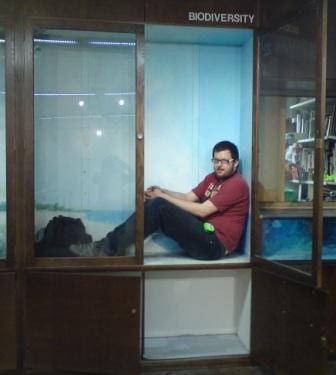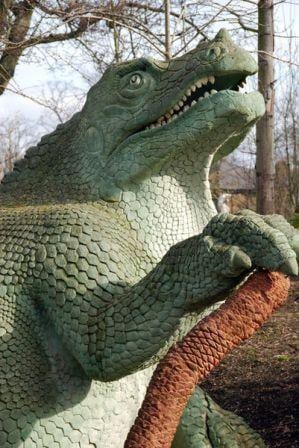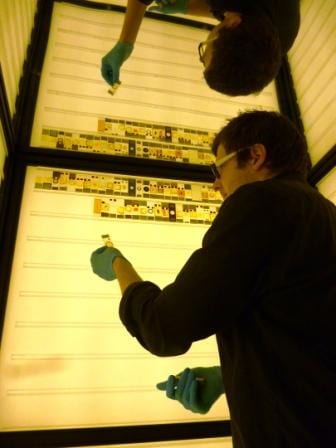On the Origin of Our Specimens: The Carnall Years
By Emma-Louise Nicholls, on 1 May 2014
The collection of specimens, known since 1997 as the Grant Museum of Zoology, was started in 1827 by Robert E. Grant. Grant was the first professor of zoology at UCL when it opened, then called the University of London, and he stayed in post until his death in 1874. The collections have seen a total of 13 academics in the lineage of collections care throughout the 187 year history of the Grant Museum, from Robert E. Grant himself, through to our current Curator Mark Carnall.
Both Grant and many of his successors have expanded the collections according to their own interests, which makes for a fascinating historical account of the development of the Museums’ collections. This mini-series will look at each of The Thirteen in turn, starting with Grant himself, and giving examples where possible, of specimens that can be traced back to their time at UCL. Previous editions can be found here
Number Thirteen: Mark Carnall (2006-2015)
The thirteenth curator is the last in this series. As they have done a number of times throughout the Museum’s history, in 2007 the role and responsibilities of the curator changed. Previous curators had been responsible for both the running of the Museum as well as the day to day and long term care of the collections. As the scope of the Museum’s operations grew to accommodate a wider remit, including public and schools programmes and an increased involvement in teaching across the disciplines, individual roles were separated. The role of manager was created to have overall responsibility for the running of the Museum, its administration, staff, uses and programmes. The curator post would then provide the expertise in collections management. To date there have been two Museum managers: Natasha McEnroe (2007-2011, now Director of the Florence Nightingale Museum) and Jack Ashby (2011-present).
As Mark Carnall is still in post as curator [at the time of writing], it was decided to write this blog as an interview. By looking back over the 179 years of the Grant Museum’s history before Carnall was appointed, a number of questions were devised to hear how he thinks things have changed, about his current role, and what he sees for the future.
1) What was your background before you became curator at the Grant Museum? Much like everyone who works in natural history museums I have a life long interest and passion for natural history. Since around the age of five I’d wanted to be a palaeontologist and I was lucky enough to follow this passion through to degree level. During my degree in palaeobiology and evolution, the career pathway that interested me by far was working in a museum context to look after and make available collections. From there, sadly as every museum professional must have to do, I spent a couple of years volunteering in, visiting and working in museums and heritage sites and centres. I then did a Masters degree in Museum Studies here at UCL whilst volunteering at the Natural History Museum (NHM) and the Grant Museum. I was fortunate enough to then get a job documenting the entomology collections here and fortunately I then got the job as the curator here. That’s really the whistle stop tour but there were a lot of moments where luck and timing, as well as hardwork and dedication came into play.
2) A number of curators spent many years at the Museum but few of them left any obviously attributable remnants. Will your successors be able to find many traces of you? When I go through the archives I do get depressed at how much many of my predecessors achieved. One section of the archive notes redisplaying all the vertebrate material in a day. Old logbooks of the Museum show huge amounts of material being acquired for the Museum. However, the reason why many of them had time to do this is because ‘curating’ the collection meant something very different. I’m happy to say that there will be plenty of traces of my time here but that’s only because I introduced the documentation system of recording who did what when virtually every time we work with objects. Sadly, this isn’t half as sexy a legacy as some of my predecessors. I very much feel like the pencil pusher curator, however, I won’t be leaving my successors a void and hopefully half as many mysteries as I have to deal with.
3) In 1895, the fourth curator Prof Weldon said ‘owing to the large amount of work entailed by heavy classes… it has not been found possible to do quite as much in the Museum as was achieved in the earlier years’. How do you feel this reflects your role in the modern day? When I meet up with former curator Rosina Down we often joke that although a lot changes we still seem to face the same problems. Both E.Ray Lankester and J.P.Hill have left reports begging for more space for the Museum. As you mentioned Weldon was snowed down by teaching and there are more than a few notes in the archives from previous curators about academic staff who don’t return collections. Not feeling like doing enough is another one of these common complaints. I think part of this is just the reality of being the curator of a small university museum but it’s also what is called ‘curatorial guilt’. When you’re tasked with ensuring the safeguarding and use of the collection for perpetuity, the job is endless. From the start you’ll never get it all done to some perfect ‘complete’ state but it can get you down if you think about it too much. The best way to stay sane is to make the collection as accessible and usable as possible and that’s something I’m confident I do in my role today. Yes, I’d like a little more time to get my teeth into the history and research stories wrapped up in the collection but I wouldn’t sacrifice teaching, research and learning use, real people engaging with the collection at all. Otherwise, why are we trying our hardest to care for it in the first place?
4) For the first 120 years, the collections were cared for by an academic. In 1948, a post was created for a dedicated curator. Do you consider yourself a non-academic and how different are the roles? I do consider myself ‘just’ the curator of the collection and this suits me just fine. In natural history, I feel that there still isn’t a concrete profession of curation. There are still a lot of academic curators, and a pressure to have a Ph.D in order to be a curator, but the reason why natural history museums are often in such a mess in terms of collections management is precisely because those academic curators were so focused on their own research that looking after the collection as a whole was a secondary priority, if at all. I see my role to make the collection as widely available as possible to all users, not just researchers. I could spend a working year on a dozen peer reviewed papers on a niche group of animals represented in the collection or I could spend that year facilitating hundreds of research uses of the collection. It’s still changing and there’s still a little bit of resentment in some quarters towards non academic curators but it’s by far a better model in my opinion.
 5) Many of your predecessors have been founding members of scientific bodies. Are you a member of any either inside or outside of UCL? If so, in what capacity? Are these questions designed to give me an inadequacy complex? If so, well done. It’s working. I’ve been a member of the Palaeontological Association since I was 15 or so. I’m a member of the natural sciences collections association (NatSCA) which is an absolutely fantastic subject specialist network for natural sciences curators both for professional advice and support but also I’ve made a great number of friends through. I’m currently on the ‘board’ of the human remains subject specialist network helping that to get up and running. I’m on the advisory board for the fantastic Museum of Life Sciences at King’s College London (traitor, I know) and I’m on the board of the Friends of Crystal Palace Dinosaurs. It sounds fancy with all this ‘board’ business but actually I’m very fortunate in my role to be supported in these advisory and support roles.
5) Many of your predecessors have been founding members of scientific bodies. Are you a member of any either inside or outside of UCL? If so, in what capacity? Are these questions designed to give me an inadequacy complex? If so, well done. It’s working. I’ve been a member of the Palaeontological Association since I was 15 or so. I’m a member of the natural sciences collections association (NatSCA) which is an absolutely fantastic subject specialist network for natural sciences curators both for professional advice and support but also I’ve made a great number of friends through. I’m currently on the ‘board’ of the human remains subject specialist network helping that to get up and running. I’m on the advisory board for the fantastic Museum of Life Sciences at King’s College London (traitor, I know) and I’m on the board of the Friends of Crystal Palace Dinosaurs. It sounds fancy with all this ‘board’ business but actually I’m very fortunate in my role to be supported in these advisory and support roles.
6) The collections have moved a number of times in their 187 year history. When you moved them to the current location, what were your primary challenges as a curator? The primary challenge for the most recent move was how we were going to remove the collection, store it temporarily and relocate it in a very very very short time and with many key decisions having to be made on the fly. I’ve written about and given conference talks on how it absolutely wasn’t the ideal way to move the Museum but I’m 80% happy with the Museum as it is today. As the curator, I often had to represent the specimen’s interests throughout the move and for various reasons a lot of compromises had to be made. One of the biggest implications was that we weren’t able to plan for where each and every object ended up so this has been why over the last three years myself, you and volunteers have been working on relocating everything. In general, often the curator has to take the tortoise role from the tortoise & the hare story. The hares are interested in the instant and quick wins but the curator knows that without the collection there is no museum. So yes activity X, Y or Z may look great or please stakeholders or get a lot of press attention but if doing so means it’s the last time those specimens can be used like that, well that’s not sustainable.
 7) Previous Grant Museum curators have included personal physician to the King, Charles Darwin’s mentor, flower preparator for the Queen, and between them have won enough medals of prestige to sink the Titanic (again). In the future, how do you hope you’ll be remembered? Sadly, I really hope I’ll be remembered as the curator who helped to professionalise the Museum particularly when it comes to the care of, use and documentation of the collection. If our loans system gets known as the ‘Carnall’ system in the future I’d be happy. The other thing I’d hope to be remembered for is fighting for the underdog. When compared to other natural history collections, with a few exceptions, the Grant Museum is unremarkable. At various times I’ve been informed that our models, fossil fish collection, microscope slide collection and general material is ‘unusable’ and I’m proud that things like Underwhelming Fossil Fish of the Month, It Came From the Stores and the Micrarium were successful and something unique about the Grant Museum.
7) Previous Grant Museum curators have included personal physician to the King, Charles Darwin’s mentor, flower preparator for the Queen, and between them have won enough medals of prestige to sink the Titanic (again). In the future, how do you hope you’ll be remembered? Sadly, I really hope I’ll be remembered as the curator who helped to professionalise the Museum particularly when it comes to the care of, use and documentation of the collection. If our loans system gets known as the ‘Carnall’ system in the future I’d be happy. The other thing I’d hope to be remembered for is fighting for the underdog. When compared to other natural history collections, with a few exceptions, the Grant Museum is unremarkable. At various times I’ve been informed that our models, fossil fish collection, microscope slide collection and general material is ‘unusable’ and I’m proud that things like Underwhelming Fossil Fish of the Month, It Came From the Stores and the Micrarium were successful and something unique about the Grant Museum.
8) You have been the Grant Museum curator for nearly ten years, what major changes have you seen in that time? A motto amongst the longer serving members of staff in our department is ‘although things seem bad, it’s better than it ever has been’. Joking aside so much has changed. When I first started the Grant Museum was still under threat of closure, it was located in a hard to find small place, there weren’t that many staff members, it was relatively unknown both within UCL and outside of UCL. It was very much perceived as a museum that should be in a museum and a bizarre little part of the university, along with a couple of other museums. Just saying that out loud makes me realise how far the Museum and the museums have come since then and I’d like to think I’ve been a part of that.
9) What do you feel is your crowning glory at the Museum? It is genuinely too hard to pick. Moving and reopening the Museum was hugely rewarding. Seeing so many of my ideas come to life in the design of the new Museum, the Micrarium and editing the book Conversation Pieces was very fulfilling. The Museum winning, not one, but two Museums and Heritage Awards was incredibly gratifying and rewarding too. Can I cop out with a vague top four or so?
10) What big changes do you think the future will bring for the Museum? It’s obviously very hard to predict. Political changes on all scales often mean a change of focus or tact for any museum, including the Grant Museum. I’m fairly certain that the Museum won’t be moving any time soon but you never know. In order to maintain the cyclicity of the Museum and on behalf of, I think all thirteen of us, can I reiterate that we need more space, more time to do things and a polite request that something be done about those academics who don’t return collections…
Emma-Louise Nicholls is the Curatorial Assistant at the Grant Museum of Zoology
UPDATE FEB 2016 – This post was modified to reflect that in August 2015 Mark Carnall left the Grant Museum to be come Collections Manager for the Life Collections at Oxford University Museum of Natural History. Paolo Viscardi begun as the fourteenth Curator of the Grant Museum on 5th October 2015, moving from the Horniman Museum and Gardens, where he had been Deputy Keeper of Natural History.
 Close
Close


